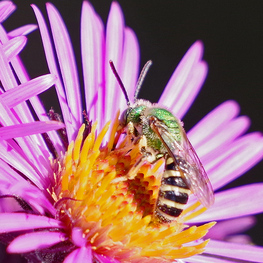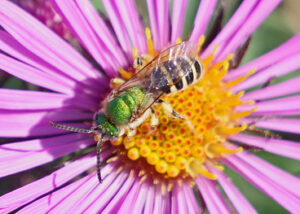Howdy, BugFans,
Isn’t this a pretty little bee!
Sweat bees are in the family Halictidae, and the star of today’s show is in the Striped sweat bee genus Agapostemon (which means “stamen-loving”). It’s a New World genus totaling 42 species between Canada and Argentina, with 14 species north of the Rio Grande. They’re sometimes called Metallic green sweat bees, but members of several other genera of sweat bees that are also green and shiny have already laid claim to that name.
Striped sweat bees are just under a half-inch long, with a green thorax. In some species, the abdomen is conspicuously striped, especially in the males. These ground nesting bees follow the usual template – they dig a vertical tunnel with chambers for their eggs, each chamber provisioned with pollen and nectar for their eventual offspring to feed on. They lay an egg and plug the chamber’s door, and when it hatches, the bee larva eats the cached supplies and pupates there.
Like most bees, they are solitary, though the Agapostemon’s definition of “solitary” is more flexible than most. They are open to other sweat bees nesting nearby, and in some species, multiple females will even share a tunnel entrance. It’s not like a honey bee hive with queens, workers and drones; beyond the common entrance each female excavates her own tunnel and chambers.
The Agapostemon are generalist feeders on a wide variety of flower families, but their short tongues restrict them to “shallower” flowers. They’re terrific pollinators of native wildflowers and of agricultural crops. Sources were divided about whether striped sweat bees are attracted to human sweat. Other Halictids certainly are – they land lightly on a sweaty arm to lap up the liquid and its minerals, and they come and go without harm (unless you brush against or swat them).
 The BICOLORED STRIPED SWEAT BEE (Agapostemon virescens) is fairly common in Midwestern and Northeastern North America (it’s even the official bee of Toronto!), and it has been recorded from coast to coast. The BugLady went cross-eyed trying to decide if this is the Bicolored striped sweat bee (aka the Virescent green metallic bee) or the nearly identical Silky striped sweat bee.
The BICOLORED STRIPED SWEAT BEE (Agapostemon virescens) is fairly common in Midwestern and Northeastern North America (it’s even the official bee of Toronto!), and it has been recorded from coast to coast. The BugLady went cross-eyed trying to decide if this is the Bicolored striped sweat bee (aka the Virescent green metallic bee) or the nearly identical Silky striped sweat bee.
[Short aside – before she uses an acronym as a substitute for the longer insect names, the BugLady checks for alternate meanings, lest she offend (and some alternate meanings are plenty offensive!). FYI, BSSB also means: Bihar Sanskrit Shiksha Board, Bulletin of the Sleeping Sickness Bureau, Billy Sparkles and the Shiny Boys, Bulletin of the Society of Systematic Biologists, and Banana Slug String Band.]
BSSBs are “polylectic” which means that they get pollen from a wide variety of plants. Look for them on flowers in the Lily, Sumac (Cashew), Rose, and Primrose families, but especially on Asters/Composites.
Several sources assured the BugLady that we don’t know the complete biography of the BSSB, so we extrapolate from what is known about the genus.
Like others in their genus, BSSBs tunnel into flat or sloped soils. When they share tunnels, they switch off doing sentry duty, with one bee sitting just inside the tunnel and blocking the entrance, guarding the tunnel from would-be parasites, allowing in only the females who belong there (although one source said that the guard sometimes gets distracted and abandons her post to chase butterflies and other flying insects). Females returning to the tunnel with pollen have the right-of-way, and exiting females must wait.
They are afoot (aflight?) from late spring to early fall, and there are probably two generations per year here in God’s Country, and more than that south of here. The early spring and the later broods have slightly different game plans.
Fertile females overwinter in a state of diapause, so the first BSSBs on the scene in spring are all females. They excavate tunnels and provision the cells, and they produce a summer generation (or two) of both males and females. In summer, hopeful males cruise the flower tops, looking for love. After the dance, mated females feed and burrow and cache and oviposit. However-many generations there are, it is only the already-fertile females of the final generation, fattened on nectar, that overwinter.
Adults leave the tunnel within 48 hours after emerging from their pupal case. Females will return to use their natal tunnel for shelter, but sources disagree about the fate of the males. Some say that the BSSB is the only species of Agapostemon that allows the male to shelter in the tunnel he emerged from, but others say that once he’s out, he’s out – at the mercy of the elements.
Ground-nesting bees need sunny, undisturbed, well-drained, moderately bare areas, and dedicating a corner of your lawn as nesting habitat will help these pretty little pollinators.
The BugLady
